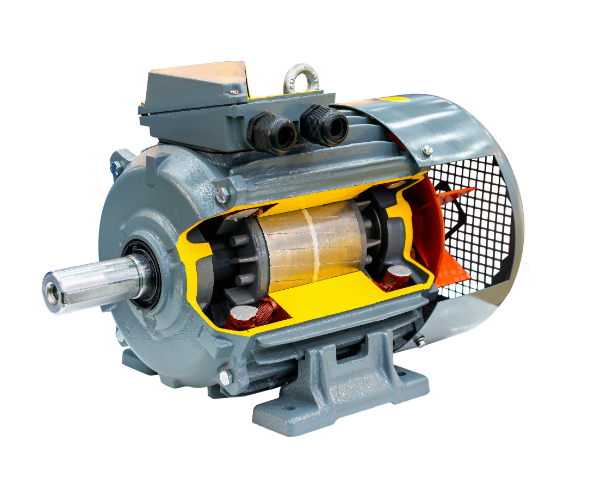Higher efficiency, stable power output, and heavy-duty equipment support are all achieved by three-phase electric motors compared to single-phase ones, which significantly reduce factory power consumption. Three-phase motors are much more energy-efficient, offering 85% to 95% efficiency versus 60% to 70% for single-phase motors. Factories can reduce energy usage by 10% to 30% if they adjust motor loads with variable frequency drives. Moreover, responsible motor maintenance can save between 5% to 10% of power wastage in the case of three-phase motors and can also lead to longer uptime, extending equipment life and further improving plant productivity.
High-Efficiency Advantages of Three-Phase Motors
Three-phase motors are more efficient than single-phase models, which is where much of the energy savings come from. On an experimental basis, three-phase motors generally give 85% to 95% efficiency, whereas single-phase motors are expected to reach up to 60% to 70%. In other words, a three-phase motor consumes less electricity per watt of power output. For instance, with a 15-kilowatt motor, if its efficiency is 90%, the energy consumed per hour drops to 16.67 kilowatt-hours, but with a single-phase motor that achieves 70% efficiency, the energy consumed per hour is around 21.43 kilowatt-hours. This difference in energy efficiency is significant when applied on a large scale over the long term.
A three-phase motor requires less current during startup, typically about 4-7 times the current in steady operation, while single-phase motors may require as much as 6 to 10 times the current (or even more when using capacitive-start). The starting current is reduced, so the motor does not draw too much load from the factory power grid during startup, reducing peak consumption in scenarios where multiple motors are frequently started, which is particularly important.

Stable Power Output Reduces Peak Power Consumption
Three-phase motors produce continuous power throughout operation, which stabilizes the power system and prevents energy wastage from unstable voltage control. In practical applications, factory equipment usually runs for long periods, and power fluctuations may cause equipment inefficiency or potential safety risks. This not only lowers the motor’s efficiency but also increases energy consumption due to voltage fluctuations triggering additional current draw.
A voltage fluctuation of 5% might increase a motor’s energy consumption by as much as 2-3%. With the help of three-phase motors, the power system becomes more stable and operates more efficiently than a factory without these motors. Moreover, three-phase motors have a high power factor (generally above 0.8), which allows them to use electricity more efficiently and decrease reactive power losses. This is particularly beneficial for factories with a large amount of equipment.
Better Adaptability to Heavy-Duty Equipment
Many key pieces of equipment in factories, such as compressors, fans, and pumps, demand a lot of power. These machines operate under heavy loads and often run at full load for extended periods. Three-phase motors are generally much better suited to these high-load applications, partly due to their design and layout. In contrast, single-phase motors may overheat or get damaged under long-term high-load operation, leading to higher maintenance and replacement costs.
Consider a high-power fan with an operating power of 50 kilowatts. When using a three-phase motor, the energy consumption per hour is about 55-60 kilowatt-hours, but when using a single-phase motor with the same power, due to lower efficiency, consumption may reach 65-70 kilowatt-hours. This discrepancy in power consumption over 24/7 operation throughout the year leads to a significant difference in electricity costs.

Variable frequency drives can be used to provide more accurate speed control of three-phase motors. In response to actual production needs, the factory can freely adjust motor working frequencies to avoid energy waste. For example, some production facilities do not need to be fully loaded all the time, so using a frequency converter allows the motor’s operating frequency to be adjusted to an appropriate level, reducing energy consumption. This enhances operational efficiency in factories and reduces electricity costs.
Extending Equipment Lifespan Reduces Energy Consumption
Three-phase motors are less prone to instability and more durable than single-phase motors during longer duty cycles. Intelligent design reduces the heat generated by the motor at high loads and friction wear on mechanical parts, thus prolonging equipment service life. Industrial data shows that three-phase motors typically last 20 years, while single-phase motors in high-intensity industrial environments may need to be replaced every 5 to 10 years.
Prolonging equipment life not only reduces the capital investment required for replacements, but also minimizes downtime and energy waste related to frequent equipment failures. As motors age or malfunction, their operating efficiency decreases, leading to higher energy consumption, which directly affects the total power consumption of the production line. This is why most factories are adopting three-phase motors, as they require less frequent repairs and maintenance, reducing production downtime and energy waste.








